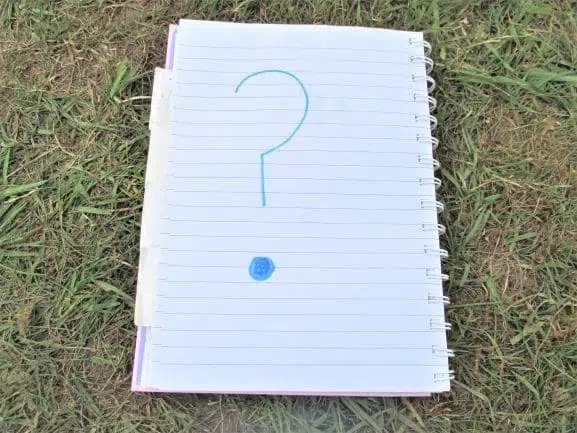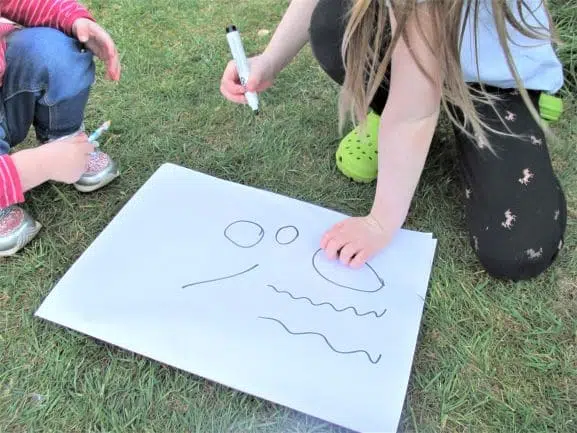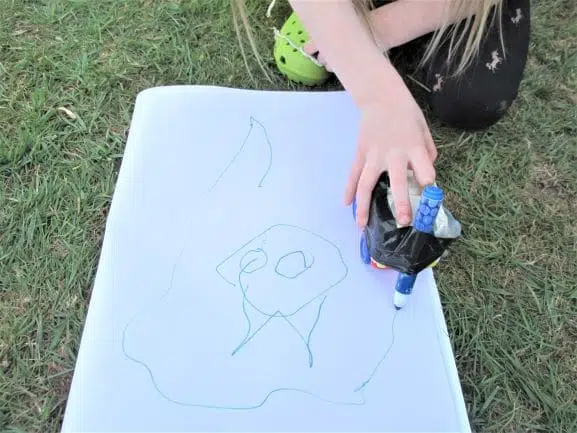Children go through a long transition from making marks to later writing in sentences. How to help them through this period will go a long way in helping them enjoy writing, and find success. But there are so many questions, such as – should pre-schoolers write on lined paper?
Most experts agree that pre-schoolers should not write on lined paper to begin with. They should write on a range of papers and surfaces using different mark-making tools. When children start writing simple setences is the best time to transition to lined paper.
There is a process to go through to get children liking the process of writing, and also being motivated to mark-make independently. But if you don’t use lined paper, what should you use? And when should children move on to lined paper? Will some pre-schoolers be able to use lined paper, and others not?
There are so many questions, and this article will answer all of them for you. This blog is just as relevant to parents as educators, and the same tips apply. There is lots of research around the importance of early writing (Source), and I am tryig to bring together that along with ten years of experience of working with young children.
In this article I am using the term pre-schoolers to mean children aged 3 to 5. I know in different parts of the world the term refers to different ages. Right, here we go…

Preschoolers Should Not Start On Lined Paper
When children begin to mark-make, their writing will look like dots and squiggles.
Later it will probably transition through mark-making lines such as zig-zags and circles, before moving on to containing a few letters in between more abstract marks.
These are all normal and crucial stages of the development, and children at all of these phases should not be writing on lined paper. Why?
Writing on paper without lines helps for the following reasons:
• Children need to be able to experiment with lines and marks, and feel they can move about the paper as they choose
• Children at this stage will be making ‘big’ movements, and big is the way to go to develop gross and fine motor and also to enjoy what they are doing. To find out the 12 main differences between fine and gross motor skills then take a look at this.
• Children need to explore mark-making up and down, left and right at this stage
• It is good for them to explore with big clockwise and anti-clockwise movements
• They are best to be using big writing tools at this stage, like fat pens or large chalks, and these are not really suited to writing on lines
• Drawing and mark-making will often be going hand-in-hand at this point, and it is good to be mixing marks with images

OK, so if they shouldn’t be writing on lined paper, then what should they write on…
What Should Preschoolers Write On?
The answer to this is – not just paper!
Any surface that can sensibly and safely contain marks is good, and also a range of different mark-making tools are good as well.
Some great examples of surfaces that are good for young mark-makers to write on include:
Wallpaper
This is something that you can’t really have enough of in the early years. I would recommend asking for donations of any old wallpaper or backing paper from staff members, and parents/carers.
Huge pieces of wallpaper unrolled and put on the floor make a fantastic mark making surface. You can also suspend it next to a wall.
Some settings I have seen have wall-paper on big wooden sticks in rolls, so the children can pull out the paper themselves and cut off huge slices with scissors. This is great for independence and motivation.
Excellent for writing with large pens, or fat pencils. It is excellent for making maps, making tracks for cars and trains, drawing scenes for stories, or making huge pictures of characters.
The Floor
Particularly I am thinking of concrete, or similar, outside. This is great for mark-making with chalks.
There are all sorts of possibilities, including making star-maps for aliens to see from space; making things like giant pizzas; drawing characters; making tracks for cars and vehicles; making drawings of their constructions; and many more!
Surfaces Covered In Chalkboard Paint
Chalkboard paint is probably the number one thing to get children excited about mark-making!
The idea is to paint large surfaces outside with it. Some good examples could be:
- A big shed
- A table and a chair
- A fence
- A pallet
- Planks of wood
There are some top tips to help you find success with this, which include:
• Children really enjoy an element of the unusual in mark-making. If you can paint something really wacky like a football with chalkboard paint, then it will fire up their curiosity
• They also like an element of danger! Things they are not normally allowed to draw or write on, such as a chair, are just the bit more enticing when they are suddenly able to do so
• They can link their mark-making to their play. Build a tower, and draw a picture of it on the fence. Make an obstacle course, and draw that on the floor next it.
Large Pieces Of Paper Or Card
This is nice and simple – just get big pieces of paper of card in different colors, and they use they to mark-make.
Many children like to combine mark-making with sticking and decorating and cutting. This is all good!
The more creativity and ownership they have of what they have created the better. So allow for lots of opportunities for a bit of art thrown in with the mark-making. Some resources that can help the process include:
• Glue
• Sequins
• Scissors
• Hole-punchers
• Tissue Paper
• Exciting mark-making tools, like pens stuck to cars or dinosaurs
• Sellotape

Real Life Materials
The more that you can make early mark-making ‘real’ the better. If children can link mark-making to the world, and see it as having different uses, then they are much more likely to give it a go themselves.
This involves lots of adult modelling. If you can find simple reasons to mark-make throughout children’s play then this is great.
For example, if they build a tower, show them how they can draw it.
If they do a fine motor challenge, show them how they can record it.
If they’re eating food in the Home Corner, show them how to write a shopping list.
Any experience like this really helps them, and any random piece of paper or surface is great for the job.
It also really helps to give them access to lots of real-life materials to write on themselves. These also work better if they are modelled to some extent so the children know what they are. Some good examples could be:
- Birthday cards
- Postcards
- Christmas cards
- Envelopes
- Letter paper
- Diaries
- Notebooks
- Paper on clipboards
- Post-it notes
When To Transition To Lined Paper
When they are beginning to write simple captions and sentences
So, I’ve gone over how to get children experimenting and motivated with early mark-making. But at what point do they need to transition over on to lined paper?
There is no doubt that there comes a point when it is good for them to start, and lined paper will have a positive impact on their writing.
I think the time is basically when they have begun learning phonics, and are starting to write simple words and even maybe some captions.
Most whiteboards that are used in schools have lines on, and these are often what children will begin with when they begin to write letters and words.
In particular, at this point lines will help them:
• Get into the habit of writing left to right, not diagonally
• It provides a visual structure of where to aim the writing
• It will begin to naturally shrink big writing
It is OK for children at this point to still write on unlined paper often, but some introduction of lined paper is definitely a good idea.
Lined paper is definitely the way to go when children begin to write sentences.
Some children will start off writing ‘through’ the line. This is totally normal. They write the word with the line going through the middle of it. It takes a while to understand that letters go on top of the line.
It takes a whole lot longer to understand about some letters going below the line also, like a ‘g’.
However, the line is there as a visual support at this point, and helps in going the right direction and reducing the size of your letters.
Conclusion
Like many things in education, there is not a clear-cut one-size-fits-all answer. But basically, if your child is beginning to write simple sentences, then writing on lines is a good idea. If they are more at the phase of exploring lines and marks, then un-lined is the way to go.
Either way, it is like the tortoise and the hare. Don’t think that because one child has developed faster, they will stay ahead of others forever. That is often not how it works. Children all have a unique path of development, and the important thing is doing the right things at the right time.
READ MORE
